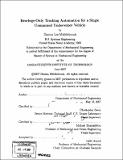| dc.contributor.advisor | Christopher Dever and Michael Triantafyllou. | en_US |
| dc.contributor.author | Middlebrook, Danica Lee | en_US |
| dc.contributor.other | Massachusetts Institute of Technology. Dept. of Mechanical Engineering. | en_US |
| dc.date.accessioned | 2008-09-03T15:35:52Z | |
| dc.date.available | 2008-09-03T15:35:52Z | |
| dc.date.copyright | 2007 | en_US |
| dc.date.issued | 2007 | en_US |
| dc.identifier.uri | http://hdl.handle.net/1721.1/42416 | |
| dc.description | Thesis (S.M.)--Massachusetts Institute of Technology, Dept. of Mechanical Engineering, 2007. | en_US |
| dc.description | Includes bibliographical references (p. 73-75). | en_US |
| dc.description.abstract | Unmanned underwater vehicles have various missions within civilian, military and academic sectors. They have the ability to explore areas unavailable to manned assets and to perform duties that are risky to humans. In particular, UUVs have the ability to perform bearings-only tracking in shallow areas near shorelines. This thesis presents a guidance algorithm for this particular mission. This thesis first presents a Modified Polar Extended Kalman Filter for the estimation problem. Bearings-only tracking is a nonlinear problem that requires some sort of estimator to determine the target state. The guidance algorithm is developed based on the relative positions of the observer and the target. In order to develop the guidance algorithm, the effectiveness of a variety of course maneuvers are presented. The effectiveness of these maneuvers are analyzed both quantitatively and qualitatively. The results from this analysis is incorporated into the final guidance algorithm. This thesis also evaluates the developed guidance algorithm through a series of simulation experiments. The experiments explore a variety of scenarios by varying speed, geometry and acoustic environment. The results of the experiments are analyzed based on estimation errors and detection time. The final conclusions indicate that some of the geometries are more favorable than others. In addition, the degree of noise in the acoustic environment affects the range of the UUV's sensors and the UUV's ability to perform bearings-only tracking for an extended period of time. In addition, the desired speed ratio is one in which the observer is either the same speed as or slower than the target. | en_US |
| dc.description.statementofresponsibility | by Danica Lee Middlebrook. | en_US |
| dc.format.extent | 75 p. | en_US |
| dc.language.iso | eng | en_US |
| dc.publisher | Massachusetts Institute of Technology | en_US |
| dc.rights | M.I.T. theses are protected by
copyright. They may be viewed from this source for any purpose, but
reproduction or distribution in any format is prohibited without written
permission. See provided URL for inquiries about permission. | en_US |
| dc.rights.uri | http://dspace.mit.edu/handle/1721.1/7582 | en_US |
| dc.subject | Mechanical Engineering. | en_US |
| dc.title | Bearings-only tracking automation for a single unmanned underwater vehicle | en_US |
| dc.type | Thesis | en_US |
| dc.description.degree | S.M. | en_US |
| dc.contributor.department | Massachusetts Institute of Technology. Department of Mechanical Engineering | |
| dc.identifier.oclc | 237797318 | en_US |
